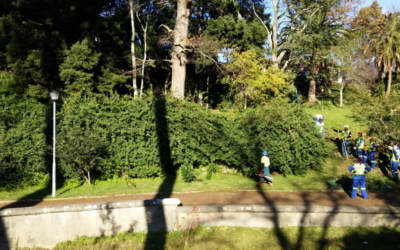Nick Fordyce
If you’re living in the Cape you must be aware that we’re in the middle of a water crisis. It’s hard to avoid reminders of this dry reality. The province’s worst drought in over 100 years, coupled with a historically carefree attitude towards water has seen us plunge into an unparalleled crisis. In November last year Level 3 water restrictions came into effect – an all-time first for the Western Cape Province. Then, less than 3 months later, council approved an upgrade to Level 3b restrictions. Electronic billboards on major motorways now remind us on a daily basis to use water sparingly and indicate how many days of water we are left with at the current rate of consumption. This is the latest effort form the city to (almost literally!) drive home the message and inspire people to make the necessary behavioural changes. Shock tactics have also been used. Drone footage of the very empty Theewaterskloof dam has been widely doing the rounds on facebook. In print media, another strategy, one of naming and shaming the worst water offenders in the city, has also been used.
This is our new reality: Climate predictions suggest droughts in the Western Cape will occur with increasing regularity. The most recent insights suggest we may be facing another El Nino period towards the end of the year, a climate scenario which will probably provide the eastern parts of the country with increased rainfall but which will mean another prolonged dry period for the Western Cape. Coupled with the growing human population in the Western Cape, full dams are something of a pipe dream.
There’s been lots of talk about creating new dams, abstracting water from aquifers and turning to desalination, but the reality is, even if there weren’t the financial, legal and logistic issues to overcome, these solutions would take far too long to address our immediate problem. They’re worth considering for the future (and they are being considered!) but for now there are only two real solutions, and only one that is within our control. We do need rain, but even if more than our average annual rainfall occurred, it won’t fill our dams – and the bad news is that the predictions are that, if anything, we’re likely to get less than average rain in the months to come. So we are left with only one solution: Collectively, we need to use less water and we need to use it more efficiently.
I have been interested in the approach that water and government officials used to try and get people to save water. The demand management approach to date has seen messages coming through the media which are pessimistic and most of the mechanisms being used to inspire behavioural change are entrenched with negative-reinforcement. For example, the shaming of heavy water users, and hiked water prices. It’s much harder to find good news stories and anything other than these negative reinforcements.
How many messages have you seen that tell the stories of increased investment in domestic grey-water systems? What about the mad rush from businesses with water-saving, water-cleaning and smart-metering technology who have inundated provincial government with advertisements and requests to take up their technology to address the water problem? Who has heard that Capetonians have brought summer consumption down by 27%, from more than 1,1 billion litres at the same time last year, to about 800 million litres this year? Admittedly anecdotally, I’ve been amazed to see how many friends and associates have made small changes at home. It’s now common place to see buckets in people’s showers, bricks in toilet cisterns and dusty, unwashed cars. Many public bathrooms now have some sort of message pinned to the wall, “Use water sparingly”, “Save water”, “water is limited” etc. Nurseries are reporting increased sales in mulch and compost and indigenous plant species with a particular spike in drought tolerant succulent species. At least one car rental company in the CBD is offering a discount to clients willing to rent unwashed cars. Even though we’re not hitting the targeted reduction in water use set by city (now at 700 mega litres per day), people are (mostly) making changes and responding to the crisis.
Zara Nicholson, spokesperson for Mayor Patricia de Lille recently said: “Although the majority of the people are adhering to the Level 3B restrictions, there are some people who are still nonchalant, and the City is tracking their water usage. They will be caught and fined.” I was surprised that the emphasis was placed on those not complying when it was worth recognising that the majority of people have made the necessary adjustments. There’s an argument to make that highlighting the good behaviour of the majority might go some way to motivating those who are lagging behind to join the cause.
Research suggests that negative reinforcement tactics work to inspire initial behaviour change. However, over time they lose effect. This is where positive reinforcement needs to come to the fore. While the negative reinforcement gets change started, positive reinforcement is what keeps it going. This is known as “Push-Pull Motivation” and it’s a strategy we need to adopt if we’re going to shift the response to this crisis to a more permanent solution. The reality of our future is that the current situation will increasingly become the norm and, consequently, we need to find ways to make the changes we’re beginning to make, permanent ones.
Over the longer term it would be as well for the powers-that-be to remember that people are more likely to respond to those mechanisms which recognise good behaviour to encourage people to change their ways.


